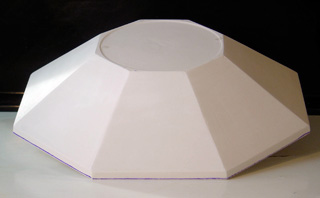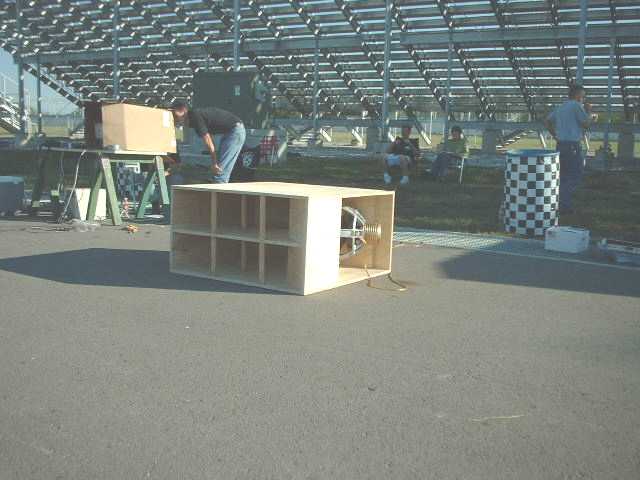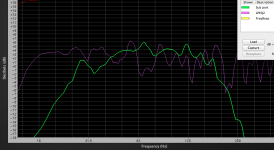Oh, I'm fully aware and I recognize the ease (and design laziness) that DSP has brought forth. If it is done correctly from the beginning there is little need for such heavy handed measures.
Much of the "issues" Earl and others have been barking about are not audible and are of no consequence.
DSP is far from lazy and represents a tremendous technology available to the audio hobbyist. The design and implementation of digital filtering represents a sophisticated synergy between advanced mathematics, software, computer hardware, and an understanding of acoustics and human audio perception. Here are some great articles on the topic by mitchco at Computer Audiophile: mitchco articles and blogs
I am sorry that you can not hear what Earl has discussed. I have found the effects to be both measurable and audible as he has.
Stick a measurement microphone in front of it and push the auto-correct button. Seems pretty lazy to me. While the technology required to design a DSP system is sophisticated, its use is not. This has led to an influx of undisciplined and poorly executed designs. While these systems might sport ruler flat responses, it is not difficult to hear that something is not quite right with them.
I can hear many of the things that have been talked about in these forums. Many of the so called “issues” have been over stated in an attempt to benefit the critic and to create doubt in the reader’s mind. Just one example that discredits the critic’s claims is the insistence that the Synergy suffers from audible port diffraction. Due to the band pass nature of a correctly designed Synergy horn any diffraction is both acoustically and electrically filtered out. Therefore it is of no consequence. Overall the Synergy provides a more complete solution to the things that actually matter than anything its critics have to offer. The commercial success can serve as some conformation of this.
I can hear many of the things that have been talked about in these forums. Many of the so called “issues” have been over stated in an attempt to benefit the critic and to create doubt in the reader’s mind. Just one example that discredits the critic’s claims is the insistence that the Synergy suffers from audible port diffraction. Due to the band pass nature of a correctly designed Synergy horn any diffraction is both acoustically and electrically filtered out. Therefore it is of no consequence. Overall the Synergy provides a more complete solution to the things that actually matter than anything its critics have to offer. The commercial success can serve as some conformation of this.
As anyone can see in the references I provided, there is much more effort involved than you have recognized to apply DSP to loudspeakers and listening spaces. Ruler flat is also not the response that is being targeted.
It is obviously best to start with well designed loudspeakers and listening spaces before applying DSP. Many audio mastering labs are employing DSP to correct the audio systems used to mix and master the music we listen to.
I am a big fan of Danley Synergy horns. I own six of them as main speakers in two home theaters. They benefitted tremendously in performance when I removed the passive crossovers and tri-amplified them with digital XO and finite impulse response correction filters.
Here is my complete Tom Danley system including a pair of Lab Subs I built from Tom's published plans. I will soon hear and measure how the PSE-144's compare. To stay on the topic of this thread, The PSE-144's use four each Celestion TF0410MR midrange drivers.
It is obviously best to start with well designed loudspeakers and listening spaces before applying DSP. Many audio mastering labs are employing DSP to correct the audio systems used to mix and master the music we listen to.
I am a big fan of Danley Synergy horns. I own six of them as main speakers in two home theaters. They benefitted tremendously in performance when I removed the passive crossovers and tri-amplified them with digital XO and finite impulse response correction filters.
Here is my complete Tom Danley system including a pair of Lab Subs I built from Tom's published plans. I will soon hear and measure how the PSE-144's compare. To stay on the topic of this thread, The PSE-144's use four each Celestion TF0410MR midrange drivers.
An externally hosted image should be here but it was not working when we last tested it.
Last edited:
The PSE-144 seems to be relatively free of "abnormalities" and is easily corrected with simple DSP.
I don't think there are any measurements published to investigate the abnormalities in PSE-144 resulting from the use of elliptical profile at the tap points.
The abnormalities would not come out in simple freq sweep, they would come out only if the CD is measured while the mids are active, it needs 2 measurements to bring out the abnormalities, ie
1) Bare response of the CD
2) Response of the CD with a low tone being produced by the mid.
Its about the lows affecting the highs, I don't think DSP can correct it.
I don't think there are any measurements published to investigate the abnormalities in PSE-144 resulting from the use of elliptical profile at the tap points.
Keep in mind, all speakers are full of "abnormalities". The midrange driver alone is abnormal as you can see in its response published by the manufacturer (Celestion):
An externally hosted image should be here but it was not working when we last tested it.
There is only one measurement of significance. It is the impulse response of the loudspeaker system. Each driver and can be measured and corrected individually if the system is multi-amped. Multi-amping permits the acoustic response of the drivers in a system to be aligned in time through digital delay (not filtering).
The measured impulse response describes the reaction of the loudspeaker as a function of time and contains all frequencies. A digital FIR filter is capable of correcting both phase and frequency through the mathematical operation of convolution.
Are you SH behind the Lab subs in front?
There are no subwoofers needed. The pair of Lab Subs with the mouth extension are flat to 20 Hz indoors in the constrained space of a home theater.
lab sub.... flat to 20? ehhhhhh
without the mouth extension a pair is barely flat to 38hz. I cant imagine an extra 2 feet of horn path gives you anouther octave of extended resp.
without the mouth extension a pair is barely flat to 38hz. I cant imagine an extra 2 feet of horn path gives you anouther octave of extended resp.
Hulkss mentions indoors in his constrained space.lab sub.... flat to 20? ehhhhhh
without the mouth extension a pair is barely flat to 38hz. I cant imagine an extra 2 feet of horn path gives you anouther octave of extended resp.
I have a pair of 12" in a BP box, the in room response at the listening position extends nearly an octave lower than the response measured at the port. Interestingly, the VLF response is better (louder) with the room doors open than shut.
Art
Attachments
lab sub.... flat to 20? ehhhhhh
without the mouth extension a pair is barely flat to 38hz. I cant imagine an extra 2 feet of horn path gives you anouther octave of extended resp.
The LF extension is from the room boundary gain first, horn mouth size second, and path length third. The LabSub pair puts out 105 dB at 2.83 volts and is capable of about 140 dB. There is headroom for a little EQ boost too. That horn easily can scare people when they hear it the first time.
The LF extension is from the room boundary gain first, horn mouth size second, and path length third. The LabSub pair puts out 105 dB at 2.83 volts and is capable of about 140 dB. There is headroom for a little EQ boost too. That horn easily can scare people when they hear it the first time.
Can you elaborate on the crossovers you are using please? The woodworking I can do...a passive crossover...no so much
Can you elaborate on the crossovers you are using please? The woodworking I can do...a passive crossover...no so much
I am using digital XO generated with Audiolense software.
Juice HiFi
Does anybody know the path length for the Dayton D250P CD?
I am trying to calculate the 1/4 wave input for my mids.
Steve
I am trying to calculate the 1/4 wave input for my mids.
Steve
Does anybody know the path length for the Dayton D250P CD?
I am trying to calculate the 1/4 wave input for my mids.
Steve
It's basically the same dimensions as a B&C DE250.
Grap the diagram off of the B&C site and you'll find your answer.
OTOH, it's about four centimeters.

I had too much coffee this morning and came up with a design for a Synergy horn that cuts the depth down by about half. It basically flips the compression driver 180 degrees.
It has one bend in the waveguide path.
One bend is better than two bends, and no bends is best of all, but this might be an interesting option if you're trying to get a big mouth on your Synergy Horn. In a lot of the projects I do I have space for a big mouth, but depth is a real issue.

Another cool thing is that the waveuide can be easily built using octagonal salad bowls, which are readily available at Pier 1, Ikea, Cost Plus World Market, etc.
The first part of the waveguide might look a little odd, but it will work, because the sound is expanding radially. Radial expansion keeps everything equidistant, which is critical for high frequency response and good phase behavior. The Paraline works a bit similar, but the Paraline doesn't expand as fast and the Paraline has multiple bends. IMHO keeping the bends to a minimum is important.
You might consider running the midranges open back. Here's some reasons to try it:
1) In a Synergy horn it's tricky to 'fill in' the midrange. A dip in the midrange is a engineering challenge I've seen in my designs, and Paul Spencer showed it on his blog too. You can also see it in the sims. One way to 'fix' the dip is to narrow the wall angle...
2) But once you narrow the wall angle, the stereo pair of Synergy Horns isn't as 'spacious' as a conventional loudspeaker. Don't believe me? Check out various reviews of Unity and Synergy horns, where they're frequently compares to a pair of headphones. The headphone thing is 'revealing' but it's not 'spacious' and sometimes space is nice
3) Removing the back cup lowers the F3 of the system. Basically you get wider bandwidth.
The 'trick' of removing the backs is particularly effective with a long narrow horn. For instance, when a horn is only 20cm deep, you're going to get cancellation from back to front starting at 425hz. But a 40cm deep horn won't experience that until 213hz.

Sort of the same idea as the Bassmaxx subwoofers, but at a smaller scale. Also a bit like a tapped horn.
I don't think I would remove the backs to raise the SPL, like the Bassmaxx does.
I'd remove the backs to change the power response.
Basically radiation from the rear of the cone will 'illuminate' the room more.
A bit like what happens in a dipole, but the front of the cone is still horn loaded so it's going to be a LOT more directional than a dipole.
Bastanis does this to a degree, and their speakers sound lovely:
6moons audio reviews: Bastanis Prometheus Mk.II
I've been interested in trying something like this. If one had a passively crossed Unity/Synergy, something like this might be employed: www.smyth-research.com
My system is DSP crossed - DEQX + a mini DSP, with two available outputs (need the miniDSP for the subs, as the DEQX controls the compression driver, mids, and bass separately). I have the original Unity mids, but could try some open back drivers (replacement suggestions?). Or, get a pair of cheap small speakers, pointed toward the back wall, and play with delay. There was a comment on this thread to latter approach, recommending bandpass limiting, but I can't find it.
Sheldon
I've been interested in trying something like this. If one had a passively crossed Unity/Synergy, something like this might be employed: www.smyth-research.com
My system is DSP crossed - DEQX + a mini DSP, with two available outputs (need the miniDSP for the subs, as the DEQX controls the compression driver, mids, and bass separately). I have the original Unity mids, but could try some open back drivers (replacement suggestions?). Or, get a pair of cheap small speakers, pointed toward the back wall, and play with delay. There was a comment on this thread to latter approach, recommending bandpass limiting, but I can't find it.
Sheldon
In my experiments, I found that going from monopole mids to dipole mids had very little effect on the overall frequency response.
You'd think the F3 of the horn would drop when you go from sealed to dipole, but it isn't affected much because it doesn't take much of a baffle to isolate the front wave from the back wave at 350hz.
The BIG problem, by far, is SPL. For instance, the Pyle PDMR5 has an efficiency of something like 95dB, while a driver like the Dayton ND91 has an efficiency of about 84.
So you have to use a LOT more power if you go dipole.
Not really the end of the world, but something to look out for.
I never tried it with any prosound 5" woofers, which would have a higher efficiency. I used the Dayton ND91 because it has more displacement than a prosound mid, is clean, and is inexpensive.
Celestion has a 5" that retails for something like $15 that looks like an interesting candidate.
90% of the 5" drivers out there won't work because their FS is too low and their QES is too high.
If you go dipole or cardioid the small drivers work pretty good.
Another thing that might work is a BG NEO 8.
Well I have built a small set of Synergy horns. The horn and mids came from Jmorkens build. He posted a sketch up model and had the GRS 5SBM measured so he could sim it in a Synergy horn. I am not much for woodwork but I figured how to get it 80% of the way built. That allowed me to have 10% error and 10% wood filler!!
I used the Dayton D250 CD for no other reason than I got a good deal on it. It should provide a little more overlap than the DE10 CD I have. I hooked up my mini DSP and slapped a 1500hz 12db LR on the unit between CD and the mids. We crossed the mids to a seal Dayton RS 12 HF in 2 cubes sealed ( belonged to another forum member, thanks for the loan) the system was clean and a pretty good listen. I have not measured it yet but hope to today. I padded the CD by ear to get the levels ok.
Fun project, I have been reading for some time about this type of system and glad for the many people who have helped people like me learn about this project
Steve
Last edited:
Looks great!
If you can't measure right away, here's a tip:
A first order crossover set at 20khz will get you close to flat.

This is because the 'natural' response of the compression driver is falling off across it's entire bandwidth. So when you combine a first order at 20khz with the naturall rolloff, you get close to flat response. For instance, in the pic above, a 1st order at 20khz will be down 27dB at 1250hz, which is just about right.
Many of my Synergy horn crossovers have been a total of one cap and a resistor or two.
If you can't measure right away, here's a tip:
A first order crossover set at 20khz will get you close to flat.

This is because the 'natural' response of the compression driver is falling off across it's entire bandwidth. So when you combine a first order at 20khz with the naturall rolloff, you get close to flat response. For instance, in the pic above, a 1st order at 20khz will be down 27dB at 1250hz, which is just about right.
Many of my Synergy horn crossovers have been a total of one cap and a resistor or two.
An externally hosted image should be here but it was not working when we last tested it.
An externally hosted image should be here but it was not working when we last tested it.
Someone posted this Synergy horn project at Parts Express. Quite a project, and the drivers are cheap cheap cheap! About $160 per side, for thirteen drivers!
- Home
- Loudspeakers
- Multi-Way
- Suitable midrange cone, for bandpass mid in Unity horn
